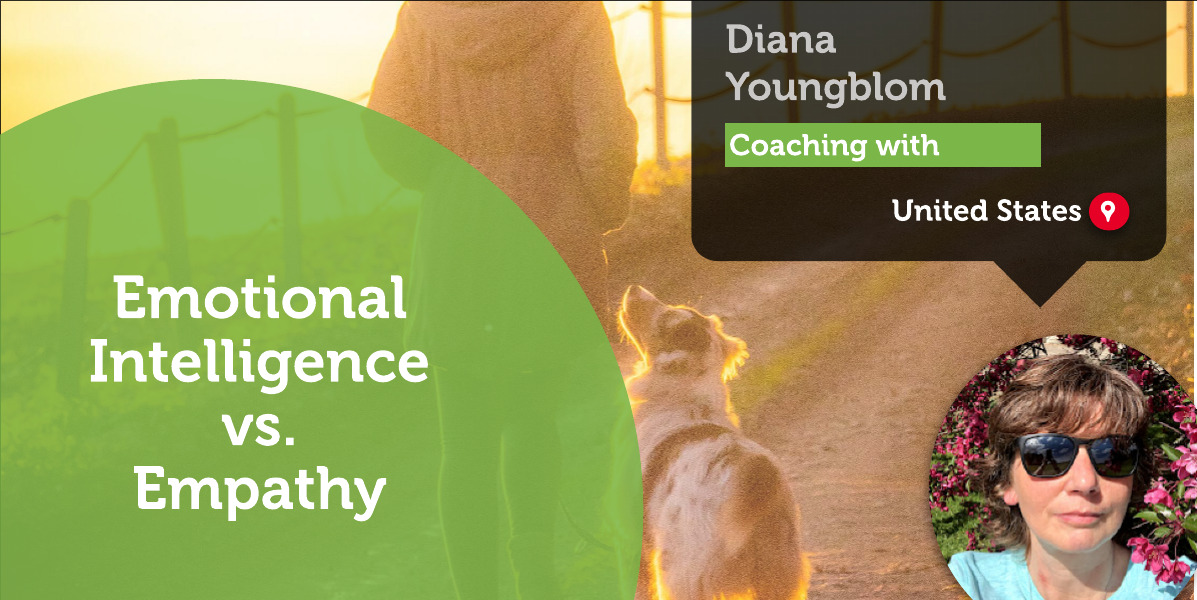A Coaching Power Tool By Diana Youngblom, Peace Development Coaching with Horses, UNITED STATES

The Importance of Emotional Intelligence vs. Empathy in Everyday Life
Emotional Intelligence vs. Empathy are both vital to coaching and similar professions but go beyond the human services career cluster. They are visible in everyday life and how humans perceive the world around them. Between 70 and 93% of communication relies on nonverbal communication. Reading body language and facial expressions requires both Emotional Intelligence vs. Empathy.
Emotional Intelligence
While emotional intelligence is vital for empathy, it, by itself, cannot substitute for empathy. Emotional intelligence recognizes two aspects of intelligence: intrapersonal intelligence, which is the acknowledgment and comprehension of oneself, goals, behavior, or intentions, and interpersonal intelligence, which is the understanding of others; their emotions, thoughts, and feelings (Stephen, Lisa, and Liz 7).
Some of the advantages of being intelligent emotionally include improved communication with others, improved relationships, acting with integrity, managing change more confidently, reduced stress levels, feeling confident and positive, fewer power games in work settings, improved career prospects, and being respected by others (Stephen, Lisa, and Liz 7). To demonstrate emotional intelligence, one needs to focus on these elements: self-awareness, empathy, motivation, self-regulation, and social skills (Gill).
Self-awareness describes individuals being conversant with or aware of the situations around them and thinking “outside the box how” to handle them (Gill). Three tips can help one become self-aware.
First, one needs to identify practices that enable them to become self-aware of their positive and negative emotions as they experience them.
Second, they need to develop routines that enable them to promote their self-awareness when interacting with others.
Third, one needs to enhance awareness by utilizing strategies that help them identify their own needs (Gill).
Self-regulation describes the ability of the coach to remain calm even when confronted or pressured in particular situations (Gill). Reflections can help the coach develop effective self-regulation. Self-regulation helps a coach adjust to various demands and lead their client through pressurized situations.
To develop self-regulation, first, one needs to identify negative and positive emotions during their day-to-day routine (Gill). When confronted with pressurized situations, one should try to remember positive times during these days to re-energize their mindset and thinking.
Second, through self-reflection, they need to develop strategies that offer room to regulate their emotions (Gill). They should provide themselves a quiet corner where they examine themselves, asking questions such as what they could have done differently, how they will formulate different strategies next time, whether they dealt with the situation in the right manner, and provide satisfactory answers, among others (Gill).
The last aspect of emotional intelligence is the ability oneself to instill social skills during their life. They should identify opportunities to enhance harmony and rapport with themselves at these times. This includes developing activities that can trigger social cohesions. A cohesive unit can realize its goals (Gill).
Empathy
Despite the advantages emotional intelligence has, there is nothing greater than empathy in itself to help others. Empathy calls for understanding one’s feelings as well as those of others (Gill). Empathy is not the intellectual understanding of the problem (emotional intelligence), sympathy, giving advice, telling one’s own story, or saying “I understand” (Rosenberg).
Building empathy is important because it helps others feel valued. Carl Rogers says, “When a person knows someone listens and has been heard they can reperceive their world in a new way.” This can be found when someone feels supported and trusts the person whom they talk to.
Listening with empathy does not include attempting to find a solution to the situation or comparing it to a similar one; it consists entirely of ensuring the other person feels compassion. There is no technique for being empathetic; it is about being in the present and staying with the energy that is there (Rosenberg).
Carl Rogers also says, “Human beings want to be heard. When a person feels someone is listening empathically they will open up and be more vulnerable and honest.” One should use appraisals and emphatic listening to another’s needs. When the person understands that someone cares, they can open up and talk about what they are struggling with (Gill).
There are other practical benefits of empathy as well. For example, “reading” another person’s needs (such as a parent “reads” an infant), understanding different perspectives, and how it is possible to stop conflict before it occurs (How might we design and build a more empathic culture?). Simon Baron-Cohen states, “Empathy is vital for subtle communication, sensitive social interaction, fine-tuned social awareness, and rapid, accurate responses to others’ non-verbal indicators of their changing mental states.”
Feelings, emotions, and behavioral expressions are at the heart of human beings. Most of these expressions are habitual and unconscious, which makes it challenging to confront them. With emotional intelligence, there is a high chance of addressing them. They can achieve this by developing their self-awareness, self-regulation, social skills, and motivation. However, empathy is also vital. While emotional intelligence is required to be able to “read” emotions, empathy is required to “feel” them.
References
Gill, Gobinder S. Emotional intelligence in coaching practices.
“How Might We Design and Build a More Empathic Culture?” Empathetic Design
Stephen, N., S. A. Lisa, and W. Liz. "Emotional intelligence coaching: Improving performance for leaders, coaches, and the individual." British Library Cataloguing-in-Publication Data
“What Empathy Is and Is Not | Empathy vs. Sympathy | Marshall Rosenberg.” Performance by Marshall Rosenberg, YouTube, Giraffe NVC
“What Empathy Isn't - Marshall Rosenberg Compassionate Communication.” Performance by Marshall Rosenberg, YouTube, Bikerusl